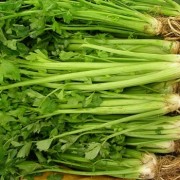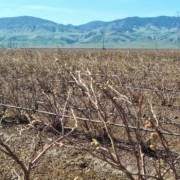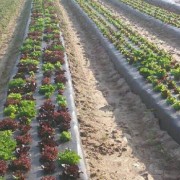Why fresh local produce tastes so different
Case Study: Celery
– By Kristin Henderson, Chief Veggie Communicator
It’s celery season out on the Flores family’s farm on Virginia’s Northern Neck. Gerardo and his son Omar are harvesting fresh, aromatic celery bunches from their fields. Then our veggie fairies deliver it straight to you within just a couple days.
If you ever needed proof that freshly harvested local produce tastes better than the stuff you get at the grocery story (which is at least a week old), do a celery taste test.
What is celery really supposed to taste like?
Until I discovered fresh local food, I thought celery was supposed to taste like grocery store celery – bitter or, at best, blah – useful as a crunchy delivery vehicle for peanut butter, various cheeses, or hummus, but otherwise best hidden in soups, stews, or salads.
Compared to that, the first time I bit into freshly harvested celery, the taste was a revelation. It was loaded with so much zingy flavor that I ate it all by itself as a snack. When I roasted it, that peppery flavor turned sweet. And when I made cream of celery soup with it, as much as I love any kind of grass-fed creaminess, I had to admit the celery was the star of the show.
Lots of flavor, lots of nutrients
If produce is full of flavor, that’s a good indicator that it’s full of nutrients as well. Flavor and nutrients go hand in hand – the longer produce sits around after it’s been harvested, the more they both fade away. Check out how much nutritional value is lost during the week (or more!) that it takes most produce to get from the farm to the grocery store.
So when produce is bursting with flavor, it’s usually bursting with nutrients, too. In the case of celery, that includes B vitamins, and vitamins A, C, and K, plus potassium, calcium, folate, and fiber.
Why does fresh local celery taste so different?
I’ve already mentioned one of the biggest reasons: the amount of time between when it’s picked and when you eat it. Grocery stores just can’t compete with local produce that’s home-delivered within a couple days of harvest, the way Seasonal Roots’ produce is. Even grocery stores that carry local food can’t offer it to you until after it makes its way through the delivery and warehousing system… which all takes time.
But there are other reasons why our local produce tastes better and is better for you. It starts with the dirt. Our local family farmers use sustainable practices to keep their soil nutrient-rich so the produce they grow in that soil can then absorb those nutrients.
Next, because our produce doesn’t have to sit in a warehouse, our farmers can pick it at the peak of ripeness, after it has soaked up all the flavor and nutrients that it can get from Mother Nature. Produce that’s picked early for a long trip may turn the right color along the way, but it doesn’t gain any nutrients or flavor in the process.
Also, during our more direct delivery process, our local produce gets handled less. So it’s less likely to get bruised, cut, or damaged. Damage speeds up the natural deterioration that makes flavor and nutrition go bye-bye.
Gerardo and Omar’s celery comes fresh from their fields with the flavor, nutrients, and roots still attached. Eat it raw or use it to cook up something amazing! We’ve got lots of healthy, tasty celery ideas on our Pinterest celery board.
ABOUT SEASONAL ROOTS
Since 2011, Seasonal Roots’ online farmers market has connected Virginia families with local family farmers who use sustainable, humane practices. Our veggie fairies – mostly moms who believe in living better through scrumptious, healthy eating, being kind to animals, protecting the environment, and spreading joy – home-deliver freshly harvested produce, eggs, grass-fed dairy and meat, plus artisan fare. We empower our members to eat better and live better with more nutritious, flavorful food that’s good for us and good for the planet. More info at seasonalroots.com.













